Communication Strategies in the Workplace: A Report
VerifiedAdded on 2023/01/12
|8
|2031
|92
Report
AI Summary
This report provides a comprehensive analysis of communication in the workplace. It begins by defining communication and its importance in building strong employee-management relationships. The literature review explores the concept of communication, its purpose, and various principles, including formal, informal, and interpersonal communication, as well as organizational culture. The report identifies and discusses common communication barriers such as language, cultural differences, physical separation, and organizational structure. The analysis highlights the significance of interpersonal communication and organizational culture in extending effective communication practices. Recommendations are provided to enhance communication, including the use of interpersonal communication methods, Skype meetings, simple organizational structures, and two-way communication strategies. The report concludes by summarizing the importance of communication and its impact on workplace dynamics and organizational success.
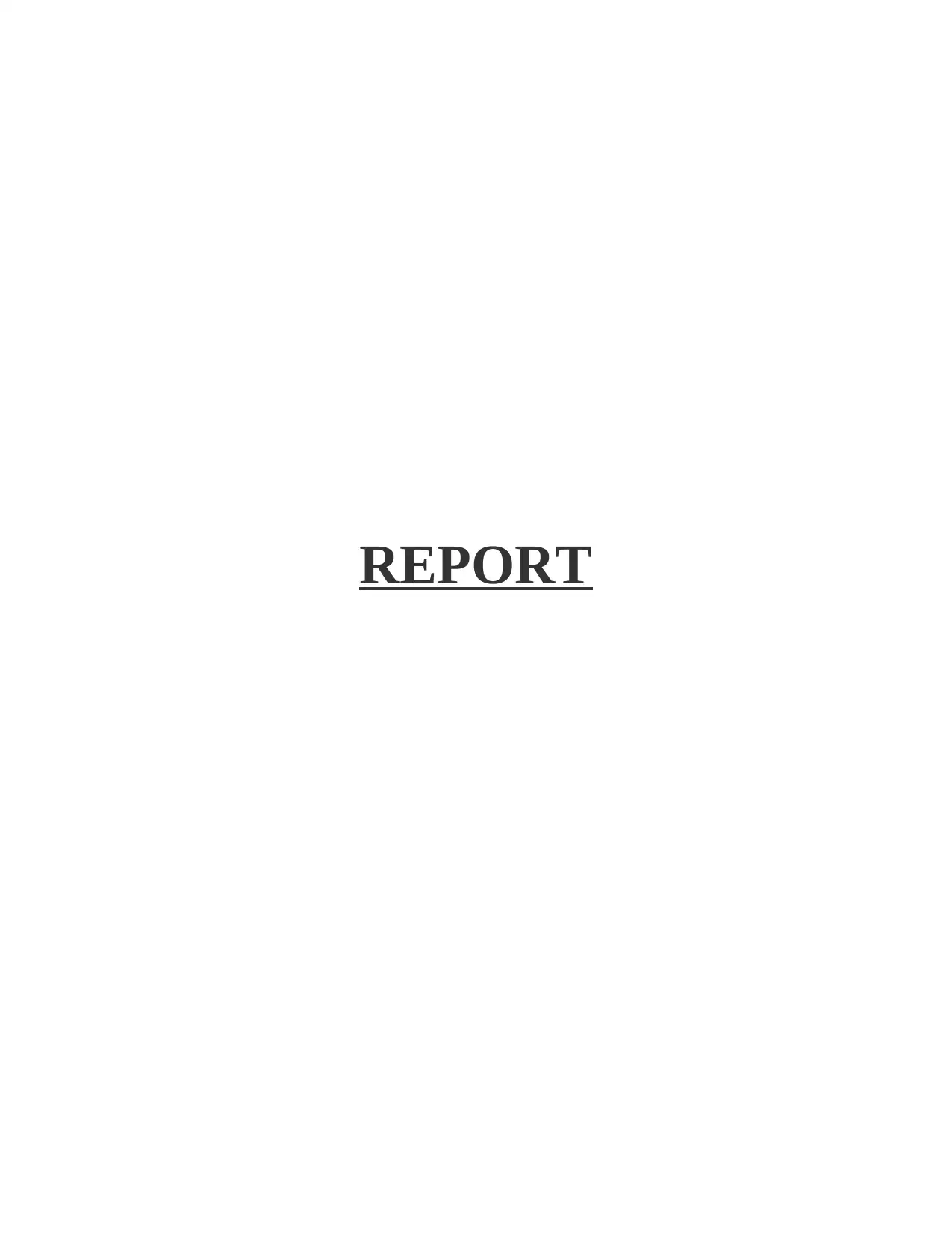
REPORT
Paraphrase This Document
Need a fresh take? Get an instant paraphrase of this document with our AI Paraphraser

TABLE OF CONTENTS
INTRODUCTION ..........................................................................................................................3
Literature Review.........................................................................................................................3
Analysis and Discussion .............................................................................................................6
Recommendation.........................................................................................................................7
CONCLUSION ..............................................................................................................................7
REFERENCES ...............................................................................................................................8
INTRODUCTION ..........................................................................................................................3
Literature Review.........................................................................................................................3
Analysis and Discussion .............................................................................................................6
Recommendation.........................................................................................................................7
CONCLUSION ..............................................................................................................................7
REFERENCES ...............................................................................................................................8
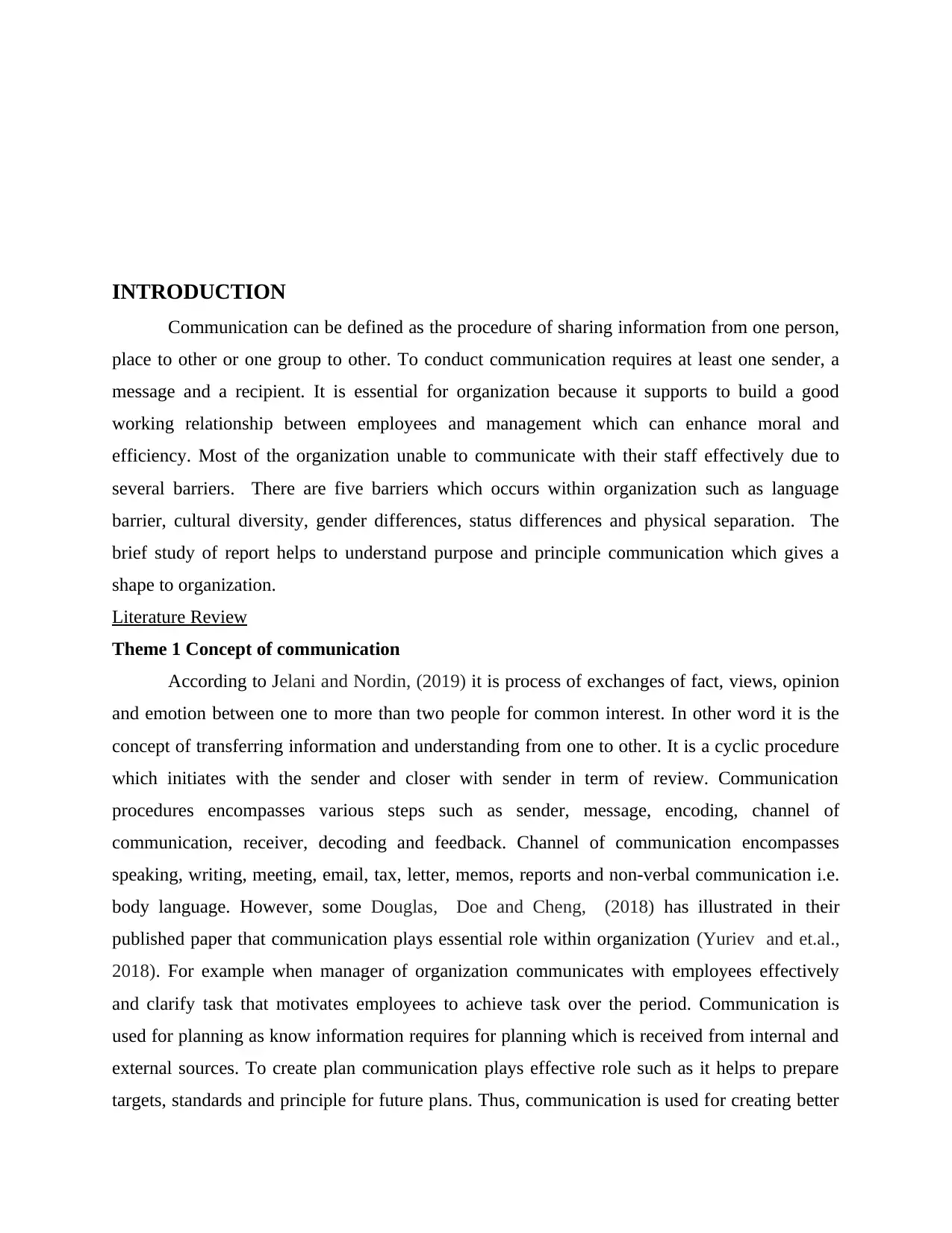
INTRODUCTION
Communication can be defined as the procedure of sharing information from one person,
place to other or one group to other. To conduct communication requires at least one sender, a
message and a recipient. It is essential for organization because it supports to build a good
working relationship between employees and management which can enhance moral and
efficiency. Most of the organization unable to communicate with their staff effectively due to
several barriers. There are five barriers which occurs within organization such as language
barrier, cultural diversity, gender differences, status differences and physical separation. The
brief study of report helps to understand purpose and principle communication which gives a
shape to organization.
Literature Review
Theme 1 Concept of communication
According to Jelani and Nordin, (2019) it is process of exchanges of fact, views, opinion
and emotion between one to more than two people for common interest. In other word it is the
concept of transferring information and understanding from one to other. It is a cyclic procedure
which initiates with the sender and closer with sender in term of review. Communication
procedures encompasses various steps such as sender, message, encoding, channel of
communication, receiver, decoding and feedback. Channel of communication encompasses
speaking, writing, meeting, email, tax, letter, memos, reports and non-verbal communication i.e.
body language. However, some Douglas, Doe and Cheng, (2018) has illustrated in their
published paper that communication plays essential role within organization (Yuriev and et.al.,
2018). For example when manager of organization communicates with employees effectively
and clarify task that motivates employees to achieve task over the period. Communication is
used for planning as know information requires for planning which is received from internal and
external sources. To create plan communication plays effective role such as it helps to prepare
targets, standards and principle for future plans. Thus, communication is used for creating better
Communication can be defined as the procedure of sharing information from one person,
place to other or one group to other. To conduct communication requires at least one sender, a
message and a recipient. It is essential for organization because it supports to build a good
working relationship between employees and management which can enhance moral and
efficiency. Most of the organization unable to communicate with their staff effectively due to
several barriers. There are five barriers which occurs within organization such as language
barrier, cultural diversity, gender differences, status differences and physical separation. The
brief study of report helps to understand purpose and principle communication which gives a
shape to organization.
Literature Review
Theme 1 Concept of communication
According to Jelani and Nordin, (2019) it is process of exchanges of fact, views, opinion
and emotion between one to more than two people for common interest. In other word it is the
concept of transferring information and understanding from one to other. It is a cyclic procedure
which initiates with the sender and closer with sender in term of review. Communication
procedures encompasses various steps such as sender, message, encoding, channel of
communication, receiver, decoding and feedback. Channel of communication encompasses
speaking, writing, meeting, email, tax, letter, memos, reports and non-verbal communication i.e.
body language. However, some Douglas, Doe and Cheng, (2018) has illustrated in their
published paper that communication plays essential role within organization (Yuriev and et.al.,
2018). For example when manager of organization communicates with employees effectively
and clarify task that motivates employees to achieve task over the period. Communication is
used for planning as know information requires for planning which is received from internal and
external sources. To create plan communication plays effective role such as it helps to prepare
targets, standards and principle for future plans. Thus, communication is used for creating better
⊘ This is a preview!⊘
Do you want full access?
Subscribe today to unlock all pages.

Trusted by 1+ million students worldwide
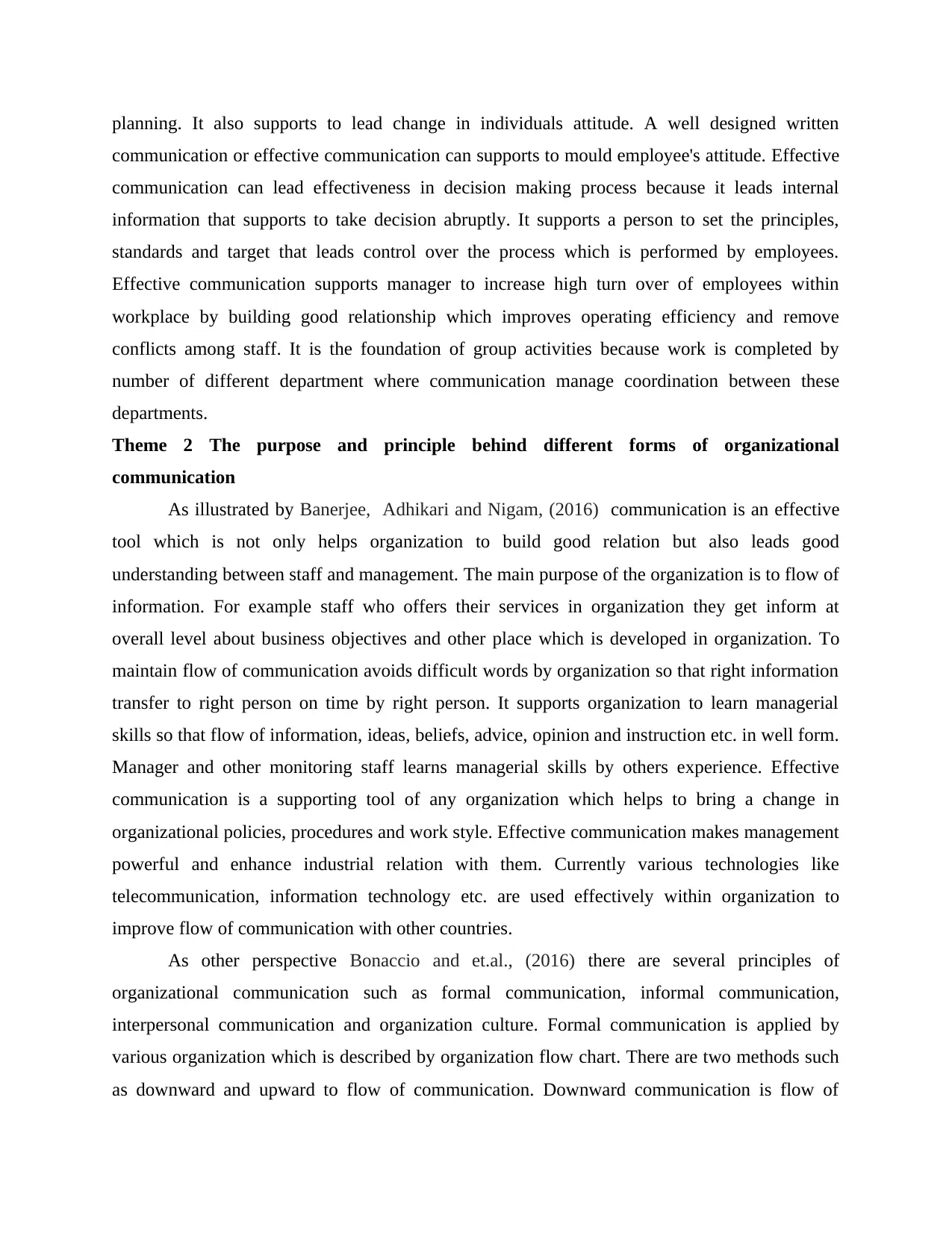
planning. It also supports to lead change in individuals attitude. A well designed written
communication or effective communication can supports to mould employee's attitude. Effective
communication can lead effectiveness in decision making process because it leads internal
information that supports to take decision abruptly. It supports a person to set the principles,
standards and target that leads control over the process which is performed by employees.
Effective communication supports manager to increase high turn over of employees within
workplace by building good relationship which improves operating efficiency and remove
conflicts among staff. It is the foundation of group activities because work is completed by
number of different department where communication manage coordination between these
departments.
Theme 2 The purpose and principle behind different forms of organizational
communication
As illustrated by Banerjee, Adhikari and Nigam, (2016) communication is an effective
tool which is not only helps organization to build good relation but also leads good
understanding between staff and management. The main purpose of the organization is to flow of
information. For example staff who offers their services in organization they get inform at
overall level about business objectives and other place which is developed in organization. To
maintain flow of communication avoids difficult words by organization so that right information
transfer to right person on time by right person. It supports organization to learn managerial
skills so that flow of information, ideas, beliefs, advice, opinion and instruction etc. in well form.
Manager and other monitoring staff learns managerial skills by others experience. Effective
communication is a supporting tool of any organization which helps to bring a change in
organizational policies, procedures and work style. Effective communication makes management
powerful and enhance industrial relation with them. Currently various technologies like
telecommunication, information technology etc. are used effectively within organization to
improve flow of communication with other countries.
As other perspective Bonaccio and et.al., (2016) there are several principles of
organizational communication such as formal communication, informal communication,
interpersonal communication and organization culture. Formal communication is applied by
various organization which is described by organization flow chart. There are two methods such
as downward and upward to flow of communication. Downward communication is flow of
communication or effective communication can supports to mould employee's attitude. Effective
communication can lead effectiveness in decision making process because it leads internal
information that supports to take decision abruptly. It supports a person to set the principles,
standards and target that leads control over the process which is performed by employees.
Effective communication supports manager to increase high turn over of employees within
workplace by building good relationship which improves operating efficiency and remove
conflicts among staff. It is the foundation of group activities because work is completed by
number of different department where communication manage coordination between these
departments.
Theme 2 The purpose and principle behind different forms of organizational
communication
As illustrated by Banerjee, Adhikari and Nigam, (2016) communication is an effective
tool which is not only helps organization to build good relation but also leads good
understanding between staff and management. The main purpose of the organization is to flow of
information. For example staff who offers their services in organization they get inform at
overall level about business objectives and other place which is developed in organization. To
maintain flow of communication avoids difficult words by organization so that right information
transfer to right person on time by right person. It supports organization to learn managerial
skills so that flow of information, ideas, beliefs, advice, opinion and instruction etc. in well form.
Manager and other monitoring staff learns managerial skills by others experience. Effective
communication is a supporting tool of any organization which helps to bring a change in
organizational policies, procedures and work style. Effective communication makes management
powerful and enhance industrial relation with them. Currently various technologies like
telecommunication, information technology etc. are used effectively within organization to
improve flow of communication with other countries.
As other perspective Bonaccio and et.al., (2016) there are several principles of
organizational communication such as formal communication, informal communication,
interpersonal communication and organization culture. Formal communication is applied by
various organization which is described by organization flow chart. There are two methods such
as downward and upward to flow of communication. Downward communication is flow of
Paraphrase This Document
Need a fresh take? Get an instant paraphrase of this document with our AI Paraphraser
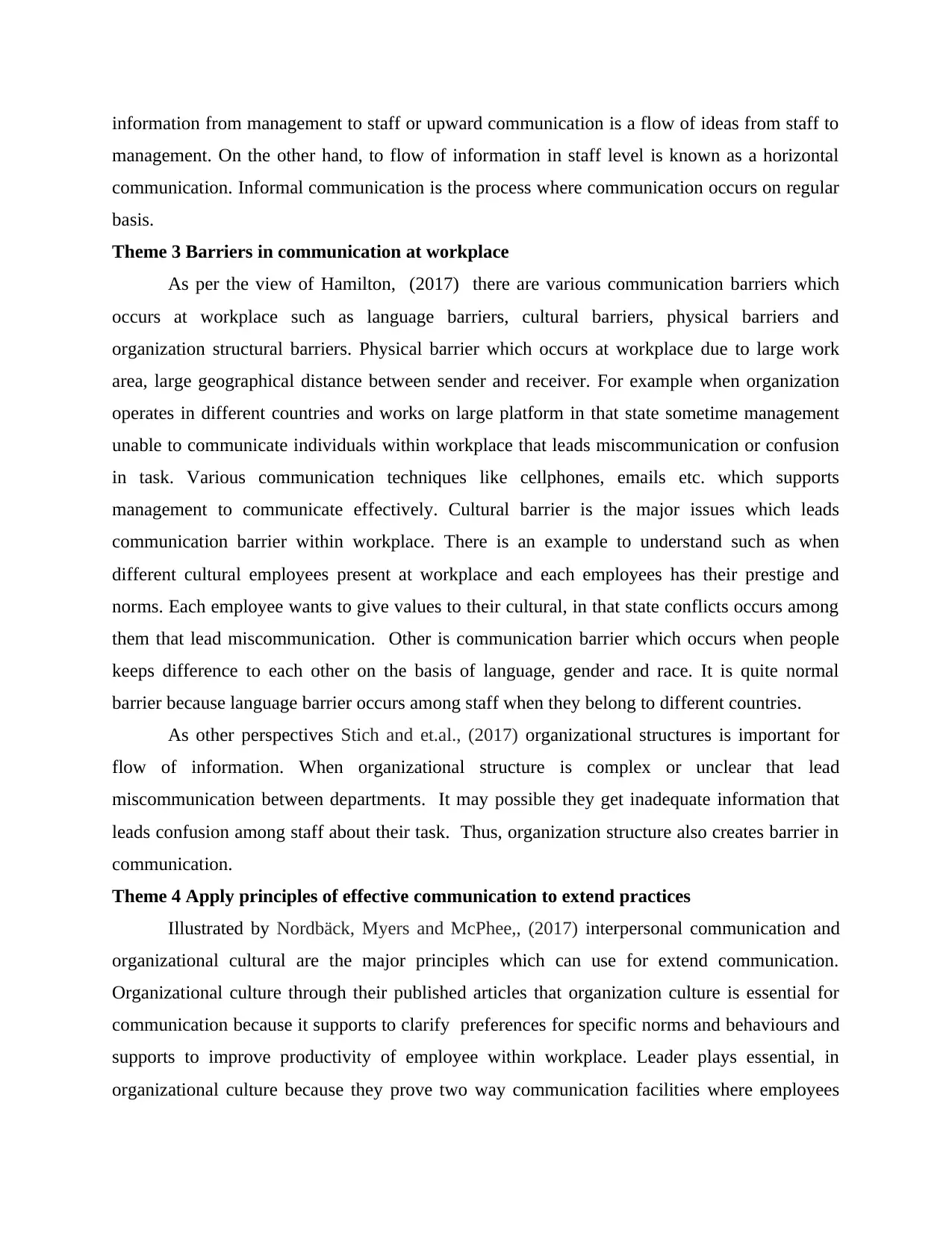
information from management to staff or upward communication is a flow of ideas from staff to
management. On the other hand, to flow of information in staff level is known as a horizontal
communication. Informal communication is the process where communication occurs on regular
basis.
Theme 3 Barriers in communication at workplace
As per the view of Hamilton, (2017) there are various communication barriers which
occurs at workplace such as language barriers, cultural barriers, physical barriers and
organization structural barriers. Physical barrier which occurs at workplace due to large work
area, large geographical distance between sender and receiver. For example when organization
operates in different countries and works on large platform in that state sometime management
unable to communicate individuals within workplace that leads miscommunication or confusion
in task. Various communication techniques like cellphones, emails etc. which supports
management to communicate effectively. Cultural barrier is the major issues which leads
communication barrier within workplace. There is an example to understand such as when
different cultural employees present at workplace and each employees has their prestige and
norms. Each employee wants to give values to their cultural, in that state conflicts occurs among
them that lead miscommunication. Other is communication barrier which occurs when people
keeps difference to each other on the basis of language, gender and race. It is quite normal
barrier because language barrier occurs among staff when they belong to different countries.
As other perspectives Stich and et.al., (2017) organizational structures is important for
flow of information. When organizational structure is complex or unclear that lead
miscommunication between departments. It may possible they get inadequate information that
leads confusion among staff about their task. Thus, organization structure also creates barrier in
communication.
Theme 4 Apply principles of effective communication to extend practices
Illustrated by Nordbäck, Myers and McPhee,, (2017) interpersonal communication and
organizational cultural are the major principles which can use for extend communication.
Organizational culture through their published articles that organization culture is essential for
communication because it supports to clarify preferences for specific norms and behaviours and
supports to improve productivity of employee within workplace. Leader plays essential, in
organizational culture because they prove two way communication facilities where employees
management. On the other hand, to flow of information in staff level is known as a horizontal
communication. Informal communication is the process where communication occurs on regular
basis.
Theme 3 Barriers in communication at workplace
As per the view of Hamilton, (2017) there are various communication barriers which
occurs at workplace such as language barriers, cultural barriers, physical barriers and
organization structural barriers. Physical barrier which occurs at workplace due to large work
area, large geographical distance between sender and receiver. For example when organization
operates in different countries and works on large platform in that state sometime management
unable to communicate individuals within workplace that leads miscommunication or confusion
in task. Various communication techniques like cellphones, emails etc. which supports
management to communicate effectively. Cultural barrier is the major issues which leads
communication barrier within workplace. There is an example to understand such as when
different cultural employees present at workplace and each employees has their prestige and
norms. Each employee wants to give values to their cultural, in that state conflicts occurs among
them that lead miscommunication. Other is communication barrier which occurs when people
keeps difference to each other on the basis of language, gender and race. It is quite normal
barrier because language barrier occurs among staff when they belong to different countries.
As other perspectives Stich and et.al., (2017) organizational structures is important for
flow of information. When organizational structure is complex or unclear that lead
miscommunication between departments. It may possible they get inadequate information that
leads confusion among staff about their task. Thus, organization structure also creates barrier in
communication.
Theme 4 Apply principles of effective communication to extend practices
Illustrated by Nordbäck, Myers and McPhee,, (2017) interpersonal communication and
organizational cultural are the major principles which can use for extend communication.
Organizational culture through their published articles that organization culture is essential for
communication because it supports to clarify preferences for specific norms and behaviours and
supports to improve productivity of employee within workplace. Leader plays essential, in
organizational culture because they prove two way communication facilities where employees

can direct communicate with their management or staff about their task issues. It is quite
effective communication principle which is used by various organization to build good relation
with their staff. Interpersonal communication method can use by organization to flow
information in other company and country by telecommunication or online communication
which is more popular currently. It concludes two type communication such as verbal and non-
verbal communication. Non-verbal communication encompasses facial expression, eye contact
and body language. While verbal communication includes effectiveness of voice which
encourage employees to give high quality work. These type communication supports to decline
confusion and misunderstanding.
Analysis and Discussion
On the basis of literature review can be analysed that communication is important tool
which supports company to meet their objectives by the help of employees. It has analysed that
there are various principles of organizational communication such as informal communication
and formal communication which are used by organization communicate with their employees.
Most of the organizations uses formal communication to transfer information from department to
others. Formal communication is executed in two forms i.e. upward communication, passes
information from staff to management or downward information, flow of communication from
management to staff (Jelani and Nordin, 2019). This is basic principle of organizational
communication but analyse that it leads conflict crisis because employees and management can't
communicate directly about their issues that is the sign of conflict. It analysed that informal
communication which is considered as principle of organization culture is not effective
communication because it is daily basis communication that is not relevant to work.
Communication barrier analysed on the basis of above study. There are various communication
barriers like physical barrier, language barrier, communication barrier, organizational structural
barrier and cultural barrier but can measure that language barrier, cultural and organization
structure barrier are predominated type barrier. These barriers create miscommunication within
workplace. It analysed that interpersonal and organization culture are major principles of
organizational communication which can follows by management that leads effective
communication between employee's and management.
effective communication principle which is used by various organization to build good relation
with their staff. Interpersonal communication method can use by organization to flow
information in other company and country by telecommunication or online communication
which is more popular currently. It concludes two type communication such as verbal and non-
verbal communication. Non-verbal communication encompasses facial expression, eye contact
and body language. While verbal communication includes effectiveness of voice which
encourage employees to give high quality work. These type communication supports to decline
confusion and misunderstanding.
Analysis and Discussion
On the basis of literature review can be analysed that communication is important tool
which supports company to meet their objectives by the help of employees. It has analysed that
there are various principles of organizational communication such as informal communication
and formal communication which are used by organization communicate with their employees.
Most of the organizations uses formal communication to transfer information from department to
others. Formal communication is executed in two forms i.e. upward communication, passes
information from staff to management or downward information, flow of communication from
management to staff (Jelani and Nordin, 2019). This is basic principle of organizational
communication but analyse that it leads conflict crisis because employees and management can't
communicate directly about their issues that is the sign of conflict. It analysed that informal
communication which is considered as principle of organization culture is not effective
communication because it is daily basis communication that is not relevant to work.
Communication barrier analysed on the basis of above study. There are various communication
barriers like physical barrier, language barrier, communication barrier, organizational structural
barrier and cultural barrier but can measure that language barrier, cultural and organization
structure barrier are predominated type barrier. These barriers create miscommunication within
workplace. It analysed that interpersonal and organization culture are major principles of
organizational communication which can follows by management that leads effective
communication between employee's and management.
⊘ This is a preview!⊘
Do you want full access?
Subscribe today to unlock all pages.

Trusted by 1+ million students worldwide
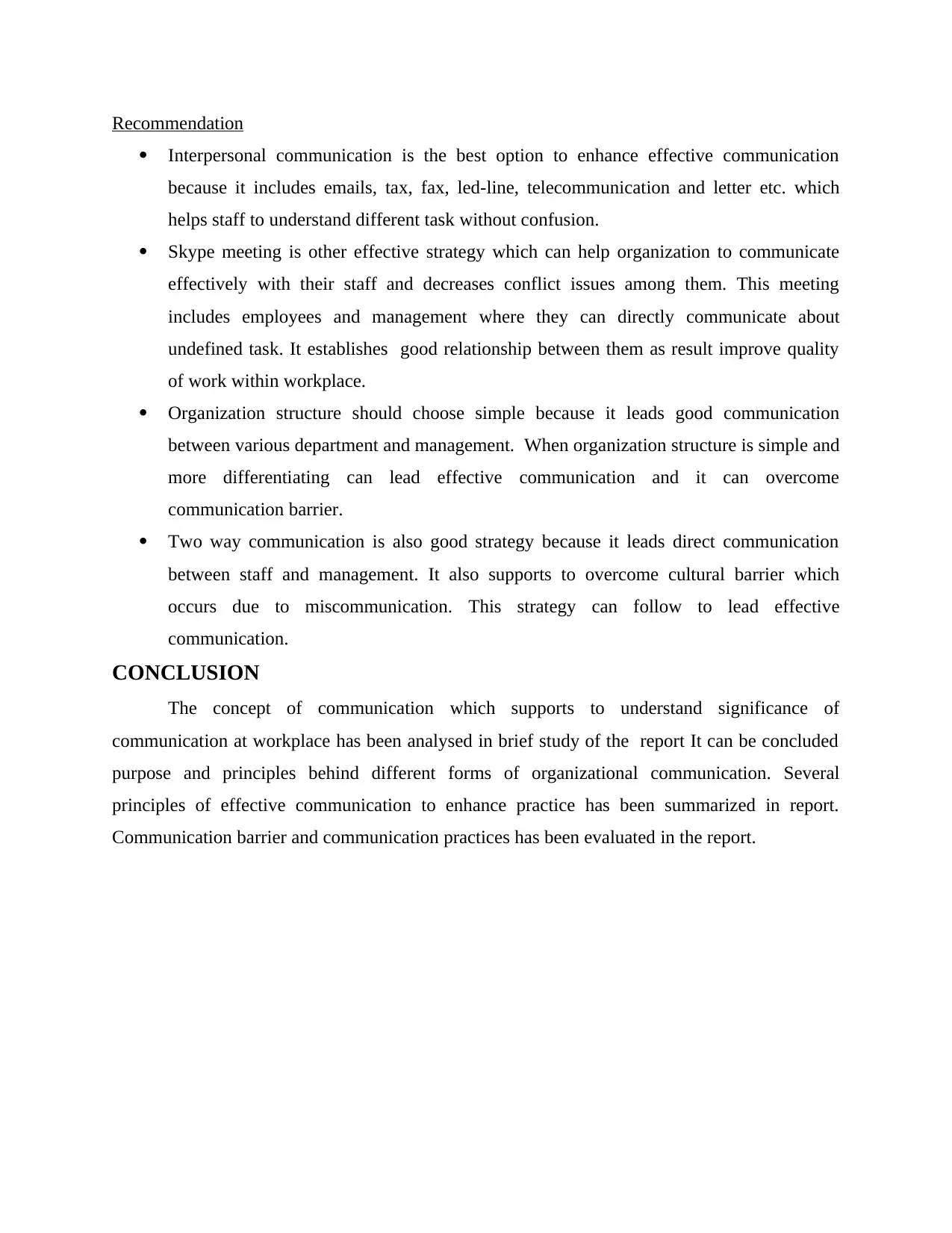
Recommendation
Interpersonal communication is the best option to enhance effective communication
because it includes emails, tax, fax, led-line, telecommunication and letter etc. which
helps staff to understand different task without confusion.
Skype meeting is other effective strategy which can help organization to communicate
effectively with their staff and decreases conflict issues among them. This meeting
includes employees and management where they can directly communicate about
undefined task. It establishes good relationship between them as result improve quality
of work within workplace.
Organization structure should choose simple because it leads good communication
between various department and management. When organization structure is simple and
more differentiating can lead effective communication and it can overcome
communication barrier.
Two way communication is also good strategy because it leads direct communication
between staff and management. It also supports to overcome cultural barrier which
occurs due to miscommunication. This strategy can follow to lead effective
communication.
CONCLUSION
The concept of communication which supports to understand significance of
communication at workplace has been analysed in brief study of the report It can be concluded
purpose and principles behind different forms of organizational communication. Several
principles of effective communication to enhance practice has been summarized in report.
Communication barrier and communication practices has been evaluated in the report.
Interpersonal communication is the best option to enhance effective communication
because it includes emails, tax, fax, led-line, telecommunication and letter etc. which
helps staff to understand different task without confusion.
Skype meeting is other effective strategy which can help organization to communicate
effectively with their staff and decreases conflict issues among them. This meeting
includes employees and management where they can directly communicate about
undefined task. It establishes good relationship between them as result improve quality
of work within workplace.
Organization structure should choose simple because it leads good communication
between various department and management. When organization structure is simple and
more differentiating can lead effective communication and it can overcome
communication barrier.
Two way communication is also good strategy because it leads direct communication
between staff and management. It also supports to overcome cultural barrier which
occurs due to miscommunication. This strategy can follow to lead effective
communication.
CONCLUSION
The concept of communication which supports to understand significance of
communication at workplace has been analysed in brief study of the report It can be concluded
purpose and principles behind different forms of organizational communication. Several
principles of effective communication to enhance practice has been summarized in report.
Communication barrier and communication practices has been evaluated in the report.
Paraphrase This Document
Need a fresh take? Get an instant paraphrase of this document with our AI Paraphraser
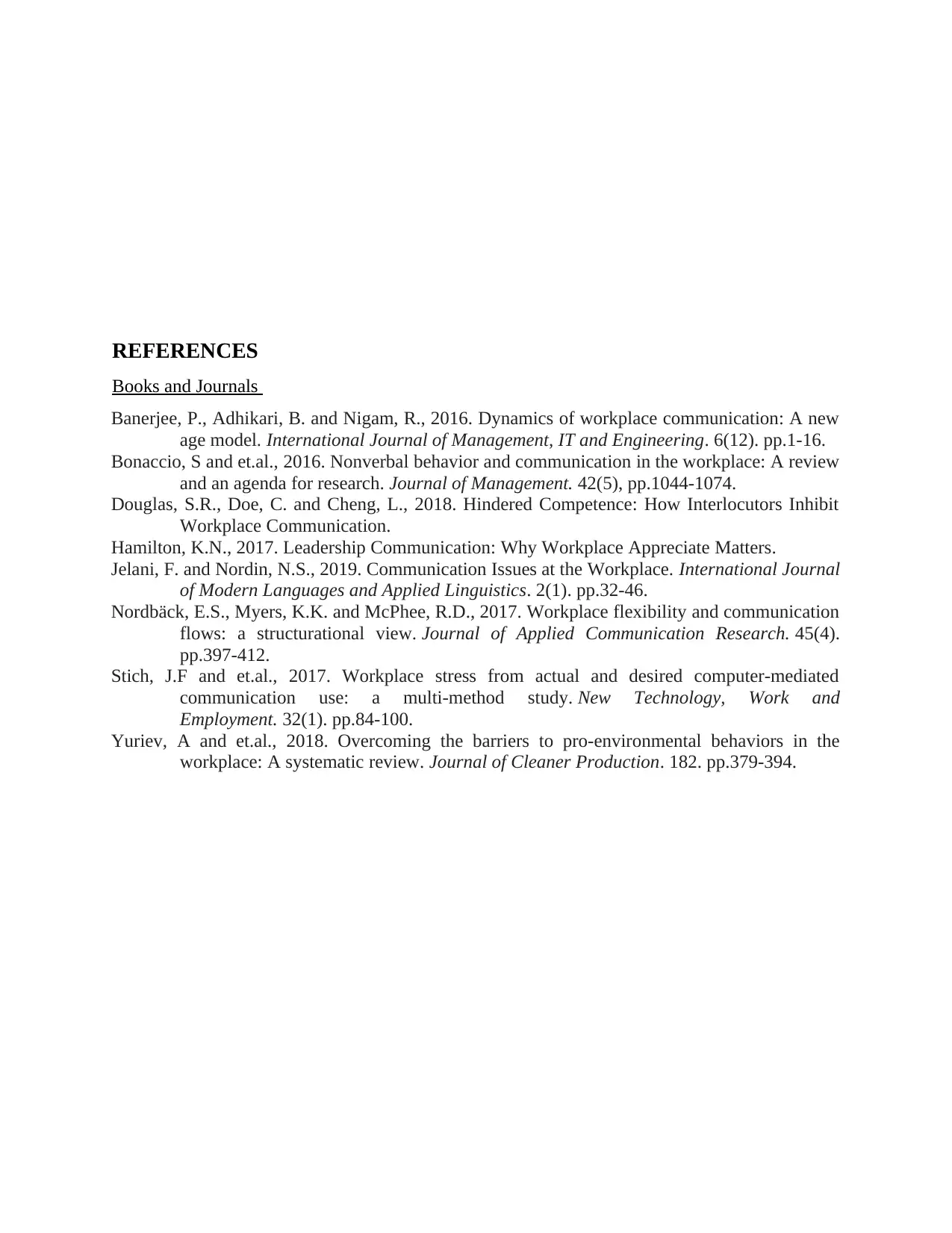
REFERENCES
Books and Journals
Banerjee, P., Adhikari, B. and Nigam, R., 2016. Dynamics of workplace communication: A new
age model. International Journal of Management, IT and Engineering. 6(12). pp.1-16.
Bonaccio, S and et.al., 2016. Nonverbal behavior and communication in the workplace: A review
and an agenda for research. Journal of Management. 42(5), pp.1044-1074.
Douglas, S.R., Doe, C. and Cheng, L., 2018. Hindered Competence: How Interlocutors Inhibit
Workplace Communication.
Hamilton, K.N., 2017. Leadership Communication: Why Workplace Appreciate Matters.
Jelani, F. and Nordin, N.S., 2019. Communication Issues at the Workplace. International Journal
of Modern Languages and Applied Linguistics. 2(1). pp.32-46.
Nordbäck, E.S., Myers, K.K. and McPhee, R.D., 2017. Workplace flexibility and communication
flows: a structurational view. Journal of Applied Communication Research. 45(4).
pp.397-412.
Stich, J.F and et.al., 2017. Workplace stress from actual and desired computer‐mediated
communication use: a multi‐method study. New Technology, Work and
Employment. 32(1). pp.84-100.
Yuriev, A and et.al., 2018. Overcoming the barriers to pro-environmental behaviors in the
workplace: A systematic review. Journal of Cleaner Production. 182. pp.379-394.
Books and Journals
Banerjee, P., Adhikari, B. and Nigam, R., 2016. Dynamics of workplace communication: A new
age model. International Journal of Management, IT and Engineering. 6(12). pp.1-16.
Bonaccio, S and et.al., 2016. Nonverbal behavior and communication in the workplace: A review
and an agenda for research. Journal of Management. 42(5), pp.1044-1074.
Douglas, S.R., Doe, C. and Cheng, L., 2018. Hindered Competence: How Interlocutors Inhibit
Workplace Communication.
Hamilton, K.N., 2017. Leadership Communication: Why Workplace Appreciate Matters.
Jelani, F. and Nordin, N.S., 2019. Communication Issues at the Workplace. International Journal
of Modern Languages and Applied Linguistics. 2(1). pp.32-46.
Nordbäck, E.S., Myers, K.K. and McPhee, R.D., 2017. Workplace flexibility and communication
flows: a structurational view. Journal of Applied Communication Research. 45(4).
pp.397-412.
Stich, J.F and et.al., 2017. Workplace stress from actual and desired computer‐mediated
communication use: a multi‐method study. New Technology, Work and
Employment. 32(1). pp.84-100.
Yuriev, A and et.al., 2018. Overcoming the barriers to pro-environmental behaviors in the
workplace: A systematic review. Journal of Cleaner Production. 182. pp.379-394.
1 out of 8
Related Documents
Your All-in-One AI-Powered Toolkit for Academic Success.
+13062052269
info@desklib.com
Available 24*7 on WhatsApp / Email
![[object Object]](/_next/static/media/star-bottom.7253800d.svg)
Unlock your academic potential
Copyright © 2020–2025 A2Z Services. All Rights Reserved. Developed and managed by ZUCOL.




